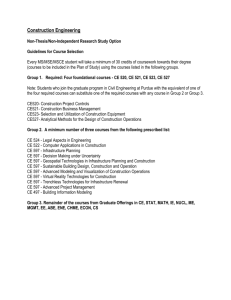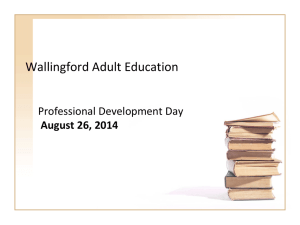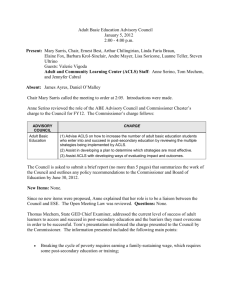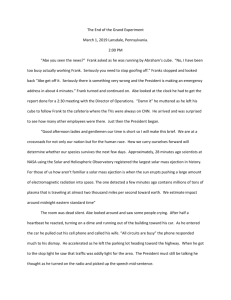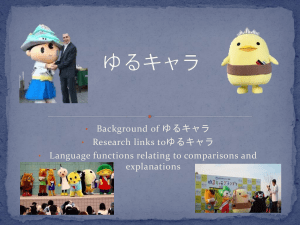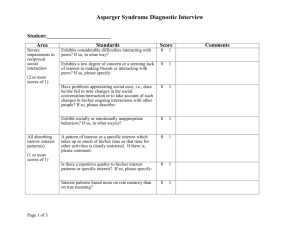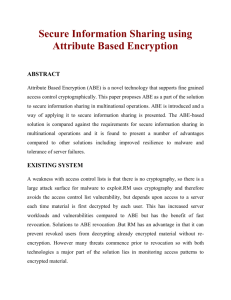Suggestions for talking with students about assessment results
advertisement
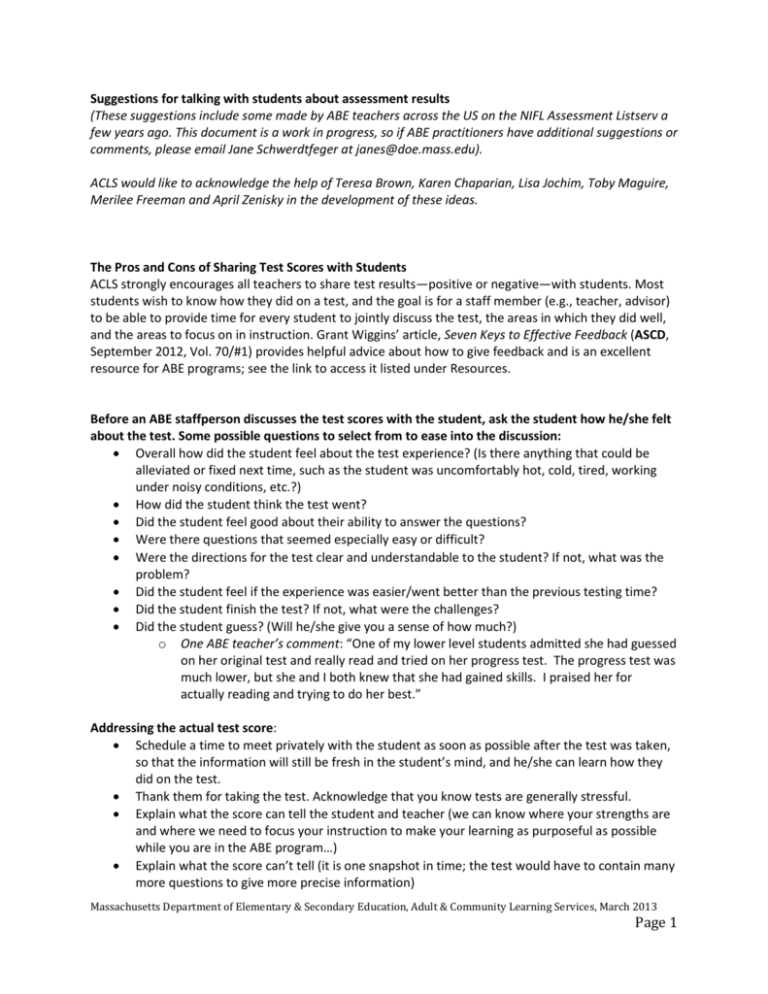
Suggestions for talking with students about assessment results (These suggestions include some made by ABE teachers across the US on the NIFL Assessment Listserv a few years ago. This document is a work in progress, so if ABE practitioners have additional suggestions or comments, please email Jane Schwerdtfeger at janes@doe.mass.edu). ACLS would like to acknowledge the help of Teresa Brown, Karen Chaparian, Lisa Jochim, Toby Maguire, Merilee Freeman and April Zenisky in the development of these ideas. The Pros and Cons of Sharing Test Scores with Students ACLS strongly encourages all teachers to share test results—positive or negative—with students. Most students wish to know how they did on a test, and the goal is for a staff member (e.g., teacher, advisor) to be able to provide time for every student to jointly discuss the test, the areas in which they did well, and the areas to focus on in instruction. Grant Wiggins’ article, Seven Keys to Effective Feedback (ASCD, September 2012, Vol. 70/#1) provides helpful advice about how to give feedback and is an excellent resource for ABE programs; see the link to access it listed under Resources. Before an ABE staffperson discusses the test scores with the student, ask the student how he/she felt about the test. Some possible questions to select from to ease into the discussion: Overall how did the student feel about the test experience? (Is there anything that could be alleviated or fixed next time, such as the student was uncomfortably hot, cold, tired, working under noisy conditions, etc.?) How did the student think the test went? Did the student feel good about their ability to answer the questions? Were there questions that seemed especially easy or difficult? Were the directions for the test clear and understandable to the student? If not, what was the problem? Did the student feel if the experience was easier/went better than the previous testing time? Did the student finish the test? If not, what were the challenges? Did the student guess? (Will he/she give you a sense of how much?) o One ABE teacher’s comment: “One of my lower level students admitted she had guessed on her original test and really read and tried on her progress test. The progress test was much lower, but she and I both knew that she had gained skills. I praised her for actually reading and trying to do her best.” Addressing the actual test score: Schedule a time to meet privately with the student as soon as possible after the test was taken, so that the information will still be fresh in the student’s mind, and he/she can learn how they did on the test. Thank them for taking the test. Acknowledge that you know tests are generally stressful. Explain what the score can tell the student and teacher (we can know where your strengths are and where we need to focus your instruction to make your learning as purposeful as possible while you are in the ABE program…) Explain what the score can’t tell (it is one snapshot in time; the test would have to contain many more questions to give more precise information) Massachusetts Department of Elementary & Secondary Education, Adult & Community Learning Services, March 2013 Page 1 o One ABE teacher’s comment: “I don't ‘explain’ it to them. I tell them learning is a continuum and scores vary as we learn. If they want to have a continuum that trends up, they need to keep working.” o Another ABE teacher’s comment: “I point out any skill areas where they have made gains. I remind them the tests show us what skills we need to practice. Then, I tell them we will practice test taking skills and do lots of timed practices using pre-tests and posttests in textbooks using bubble answer sheets. Often students freeze when they are timed. I remind them it is alright to do all the easy questions first and come back to questions that require more thought. “ In discussing the score, discuss what aspects the student did well, but also the aspects in which the student and teacher will want to focus their efforts. Where possible, be specific and actionable. For example, Lisa Jochim, Director of the UMASS Dartmouth Worker Education Program, suggests comments such as the following: o This Language Complexity part of your BEST Plus score could mean that you need to talk more and give more details. o When I looked at your CLAS-E Writing test, I saw that you lost points because you didn't use periods and capital letters. o You did well on the folio but I think combining sentences gave you problems in the multiple choice section of the test. With more class practice, I am sure your next test will show improvement. o On the folio, you didn't write about what the prompt asked for. You must read and follow the directions. o The MAPT Score Report shows you did well with____ but not so well with ____.... o This score on your TABE 9 Level M was a big improvement for you. It means that next time you move up to the next level test book. If possible, tie the test results to student goals, and discuss how the test is moving them closer to achieving their goal(s) Students are being taught what the curriculum is, and the test measures what they know relative to that instruction. At the end of the year, both Teresa Brown at the Cambridge Community Learning Center and Toby Maguire at the Cape Cod Community College ABE program produce reports for students. The Cambridge CLC outlines for ESOL students what their scores were on tests and where that landed the student in terms of levels, so they can see the changes they made. The program also shows if students go down, explaining that it is one measure of their progress, not the only way, and is coupled with their attendance. The Cape Cod Community College program produces a report card that shows students their overall attendance, their scale scores on pre- and posttests, their curriculum framework level, and the goals which were met. Discussing scores that were lower than expected: Explain that “just as one grade does not determine all that a student is or isn't,” one test score is a snapshot of one point in time, at best. Explain how the score range functions in MAPT: Because test scores are a snapshot and they are not a perfect measure of what a person knows, there is always a small amount of imprecision in test scores. This imprecision is expressed as a confidence band around a student’s observed score, and this confidence band provides a range in which a person’s performance most likely actually is. So, the scale score range may be a useful tool in the conversation as well. Massachusetts Department of Elementary & Secondary Education, Adult & Community Learning Services, March 2013 Page 2 Explain that standardized test scores are used along with many other types of information (i.e. in-class assignments, observations, student participation in class, a variety of classroom, teacher-made assessments) when deciding about instructional priorities. One Massachusetts Teacher reminds students that “now he/she has seen what the test is like, and what parts were hard, and so practicing things that you have found were difficult will help you learn from it and do better the next time.” This same teacher also tells students that they will be taking the test again, and will have a chance to show improvement, and that learning is a process. o An ABE teacher’s comment : “As a teacher it is my responsibility to use whatever assessment works, and interpret what I can from what doesn't make sense. For instance, I have had students come to my class who have passed the Reading portion of the GED. THEY KNOW they can read well enough to pass that portion, but after several semesters they cannot raise their math high enough on the TABE to qualify to take the GED practice test, etc. At this point I review with them the fact that EVERYTHING IN THE GED IS BASED ON READING and just passing the Reading portion of the test may not mean their Reading skills are adequate to pass the Math portion! After a semester working on Reading and Math they easily reach proficiency on the TABE and go on to complete the GED.” o Another ABE teacher’s comment: “The important dynamic here is to realize that quitting is not an option if a student hits the wall. By problem-solving this dilemma we have all shared an accomplishment!” o Another ABE teacher’s comment : “I urge my students to view testing in preparation for the GED as a continuum, not an event. Given that the majority of people who we serve simply come in the front door, take the TABE, take the GED, and walk out, we must take a directive approach toward students needing to take classes… If test anxiety is an issue: Find out what aspect makes them anxious (fear of failure, fear of math?) and try to alleviate the fear. Can practice help the student? The teacher may decide to develop instructional activities that help students feel more comfortable with the skills/content being tested, so long as the activity is not a mostly mirror image of test items. See Ron Hambleton’s paper on how to do well on standardized tests under the Resources section. o One ABE teacher’s comment: “Most students who have been with us for any amount of time want to know their scores, and discussing them is an opportunity of many sorts-tests are a reality, and discussing results opens up the chance for us to learn more about the student and possibly if there is text anxiety--which I have found to be much higher than many students let on until you've done some work with it.” o Another teacher’s comment: “The first thing I always do is ask the student how she thought the test went—If she starts off with “Well, I felt kind of sick and nervous…”, then you might not have such a hard job discussing the scores with her. Sometimes I think that we forget how much simple day-to-day changes can affect a test score. It makes the conversation much easier if you and the student can both say, “Well, it looks like Tuesday wasn’t the best day, but if we do some work on test anxiety and keep practicing, next time will be better.” Massachusetts Department of Elementary & Secondary Education, Adult & Community Learning Services, March 2013 Page 3 Teacher involvement and curriculum/instruction: Share the test results with students individually and set some obtainable, realistic goals for them to work towards before the next test. 1 Test scores could help inform how teachers put together student groups for class work and differentiate instruction for certain students.2 Do teachers go over the test results of the learning gains tests to determine where students, individually or as a class, had difficulty? Do any patterns emerge? Do any trends bring about a discussion of whether or not curriculum could be adjusted? (See the ACLS Analyzing Test Results Document regarding what is appropriate or not to do). o Another ABE teacher’s comment: “Yes, here are many variables involved in student performance and one of them is instruction. I think teachers thinking reflectively when faced with unexpected test scores is a critical part of professional competence and growth. I will include a reflective example of my own to illustrate. I noticed in my own teaching that I thought that the students were able to do certain things as readers that were not reflected on an assessment. What I realized was that I was doing a lot of prompting when working with students while they were reading. My students could perform well with assistance, but not when working independently. I realized that I needed to step back and observe when they were reading independently and not provide prompting all the time. I then had more a more realistic view of what the students could do when they did not have any teacher support.” Sarah Resources: How to Do Your Best on Standardized Tests: Some Suggestions for Adult Learners, Ron Hambleton and Steven Jirka in Adventures in Assessment (Vol. 16, Spring 2004) Retrieved March 5, 2013 at http://www.sabes.org/resources/publications/adventures/vol16/vol16.pdf Seven Keys to Effective Feedback, Grant Wiggins. ASCD (Vol. 70, Number 1), pages 10-16 Retrieved January, 2013 at http://www.ascd.org/publications/educationalleadership/sept12/vol70/num01/Seven-Keys-to-Effective-Feedback.aspx Testing—Standardized and Otherwise—and the Massachusetts ABE Pilot Test: A Curriculum Unit for ABE Classes, Jenny Lee Utech, with Ruth Byrne and Susan Prior, for the Massachusetts Department of Elementary and Secondary Education’s Adult and Community Learning Services, March 2005 Found at http://www.doe.mass.edu/acls/assessment/ under “MAPT” 1 Three Ways Student Data Can Inform Your Teaching, by Rebecca Alber, Edutopia, December 6, 2011. Retrieved January 20, 2013 at http://www.edutopia.org/blog/using-student-data-inform-teaching-rebecca-alber 2 Ibid Massachusetts Department of Elementary & Secondary Education, Adult & Community Learning Services, March 2013 Page 4


